Technical specification documents are crucial for aligning technical implementations with business goals and providing a reference guide for project execution. They ensure clear communication among team members and stakeholders, prevent the development team from wasting time and effort on unnecessary steps, and mitigate misunderstandings and development errors.
A wise developer will always consult the technical specification before writing a single line of code.
In this guide, you’ll learn why it’s essential to use a technical specification, who writes it, what it contains, and how to write one. We’ll also highlight the different types of technical specifications and various ways to control them. Plus, we’ll show you how monday dev can help manage your tech specs.
Try monday devWhat is a technical specification?
A technical specification — also known as a tech spec — is a comprehensive document outlining the detailed requirements, design, and functionality of a product, system, or project. It serves as a blueprint for engineering teams, bridging the gap between business requirements and technical implementation. It covers all the vital, nitty-gritty information about the product development process and lays out the technical requirements necessary to achieve the project’s goals.
After reading a technical specification document, the development team and stakeholders should know:
- How the proposed product is going to behave
- What it can and can’t do
- How it’s going to be developed
- All systems that are going to be used/changed/created to assist development
- Security measures for data privacy
- The plan for rollout and rollback if necessary
- Business-related metrics
- Support and maintenance plans
- The project timeline
Technical specification vs. functional specification
A technical specification is sometimes confused with a functional specification. While both documents lay the groundwork for a successful project, there are key differences.
A functional specification is based on business requirements. It focuses on user experience by looking at product functionality. In contrast, a technical specification focuses on internal programming, technical standards, and performance requirements. It includes plans for implementation, testing, and the benefits of specific features, and defines all the technical requirements.
Functional specification Technical specification Focus: Describes what the system should do from a user's perspective Details how the system will be implemented technically Content: Outlines features, functionality, and user experience Covers internal programming, technical standards, performance requirements, and implementation plans Audience: Primarily for stakeholders and end-users For developers and technical team members Purpose: Defines the "what" of the software project Explains the "how" of the project implementation Level of detail: Focuses on high-level user requirements and product behavior Provides in-depth technical details, including architecture and technology stack Timing: Usually created earlier in the project lifecycle Typically follows the functional specification, translating requirements into technical solutions
Put simply:
A functional specification describes what you want from your software development, and a technical specification details how you get there.
Why it's important to use a technical specification
Using a technical specification is crucial for successful project development and execution. It keeps everyone on the same page, provides clarity, and prompts questions throughout the process. Here are the key reasons why it’s important:
- Clarity and precision: Technical specifications provide clear, detailed requirements, reducing ambiguity and ensuring all stakeholders have a consistent understanding of the project.
- Risk reduction: By identifying potential technical challenges early, specifications allow for proactive risk mitigation and help prevent scope creep.
- Quality improvement: Detailed requirements enable comprehensive test plans and define acceptance criteria, leading to higher quality outcomes.
- Efficiency boost: A well-written specification can save time and money by reducing errors, misunderstandings, and the need for rework.
- Productivity enhancement: Technical specs serve as a blueprint, eliminating the need for trial and error and allowing developers to focus on immediate tasks.
- Improved communication: Specifications provide a common language for all team members and stakeholders, facilitating better collaboration.
- Documentation: They serve as a reference for the project, both during implementation and after completion.
- User satisfaction: By clearly defining features and functionality, tech specs help ensure the end product meets user needs.
- Investment protection: A thorough specification can be seen as an investment, potentially saving significant costs during implementation.
- Project alignment: They help ensure that technical implementation aligns with business goals and objectives.
By providing these benefits, technical specifications contribute to more successful project outcomes, improved team collaboration, and higher-quality end products.
Who writes technical specifications?
Depending on the organization and the nature of the project, a technical specification is typically written by one of the following:
- Engineers: Often the engineer who will build the solution or be the point person during implementation writes the technical specification.
- Technical leads: For larger projects, technical leads may create the specification.
- Project leads: Sometimes project leads take on the task of writing technical specifications, especially for complex projects.
- Senior engineers: Experienced engineers with deep knowledge of the product/project may be tasked with writing the specification.
- Technical writers: Specialized professionals known as technical writers or technical authors are often employed to create technical specifications. They have expertise in conveying complex technical information clearly and concisely.
- Spec writers: Also known as specifiers, these professionals specifically focus on developing construction specifications for projects in the architecture and construction industries.
These individuals collaborate with various stakeholders, including product teams, developers, and subject matter experts, to gather information and create comprehensive technical specifications that guide project implementation.
What are the key components of a technical specification?
The key components of a technical specification typically include:
- Front matter: Title, author(s), team, reviewer(s), creation date, last updated date, and reference link such as an epic, ticket, issue, or task.
- Introduction: Overview of the project, its goals, and objectives.
- Purpose and scope: Outlines the technical solution’s intended outcomes.
- Functional requirements: Describes features, functionalities, and performance criteria.
- Design requirements: Specifies user interface and design elements.
- Technical standards: Details industry standards, protocols, and regulations to follow.
- Solutions: Explains the approach to tackle each element of the project.
- Testing requirements: Outlines test plans, cases, and acceptance criteria.
- Delivery requirements: Specifies delivery dates, installation, and training needs.
- Support and maintenance: Includes information on warranties, maintenance, and technical support.
- Success evaluation: Defines how the project’s success will be measured.
- Work breakdown: Details the tasks and timeline for implementation.
- Further considerations: Addresses potential challenges or alternatives.
- End matter: Includes any additional relevant information or appendices.
What to do before writing a technical spec?
Before writing a technical specification, consider the following key steps:
- Gather existing information: Collect and review product/feature requirements, technical standards, and any relevant documentation related to the project.
- Understand the problem: Clearly state the problem in detail and brainstorm potential solutions.
- Select a solution: Choose the most reasonable solution from the options you’ve generated.
- Consult with experienced engineers: Discuss your proposed solution with knowledgeable colleagues, explain your thought process, and gather their feedback.
- Define your audience: Identify who will read and use the specification to tailor the content appropriately.
- Establish clear goals: Determine the purpose of the technical specification and what it aims to achieve.
- Create an outline: Develop a structured outline to organize your thoughts and ensure all necessary components are included.
- Block off writing time: Schedule dedicated time in your calendar to write the first draft of the technical specification.
- Use a collaborative document editor: Utilize a shared platform for team access and collaboration.
- Obtain a technical spec template: Use a template as a starting point for your rough draft.
By following these preparatory steps, you can create a more focused, comprehensive, and effective technical specification.
What are the steps to complete a technical specification?
Let’s look at a practical example of a technical specification at work. Suppose you’re designing a new food delivery app. A comprehensive technical specification will help clarify your goals and nail down the details.
Preliminary questions
First, you’d need to establish the way your app behaves. You want to answer questions like:
- What do you want your app to do?
- What problem does it solve for the user?
- How will your product improve on existing food delivery apps out there?
Here’s your chance to be specific about what your system can and cannot handle. This section paints a detailed picture of what you want to build, including specific user stories.
Set limitations
Next, you need to establish what is not possible for the development of your app. This is called the “out of scope” section of the technical specification. The project manager needs to confront any grand, unrealistic ideas from stakeholders with experience-based evidence. For example, the app cannot accept payments in cryptocurrency.
Determine your approach
In this section, you can outline how you plan to tackle each project element. You should also include your reasoning. For example, if you want to use biometric security for user login, here is where you explain why it is the best approach and how you plan to execute it. Another important specification is security and privacy. Your document should outline how you plan to protect user privacy and prevent breaches.
Testing and support
Finally, you outline your testing, deployment, and support strategies. For example, if you have arranged for a 100-person alpha test, detail that here. You can specify what platforms you’ll release on, how you’ll monitor feedback, and how you’ll offer support.
What are the different types of technical specifications?
There are several types of technical specifications, each serving a specific purpose in various industries and projects:
- IT technical specification: Addresses IT infrastructure projects, system updates, and technical requirements for IT teams.
- Website technical specification: Outlines technical requirements for website development, including design, functionality, and user experience.
- Software technical specification: Describes the software application’s technical requirements, including the software architecture, programming languages, database schema, and user interface design.
- Agile technical specification: Incorporates user stories and acceptance criteria, allowing for continuous feedback and adjustments for each iteration or sprint in Agile development.
- Product technical specification: Serves as a blueprint for product development, detailing features, functionality, and technical requirements.
- Equipment technical specification: Provides detailed information about technical aspects of equipment, including manufacturing, power requirements, and safety considerations.
- Architecture specification: Outlines the structure and design of a system, explaining software architecture and hardware requirements.
- Performance specification: Defines operational requirements and performance criteria for a system.
- Technical design specification: Describes the product’s functions and outlines how users will interact with it.
- Open specifications: Allow flexibility and freedom of choice in product creation, often used by governing bodies to set standards.
- Closed specifications: Provide precise instructions, including safety specifications, necessary materials, and product design.
10 ways to control technical specifications
By implementing these effective control measures, you can maintain high-quality, up-to-date technical specifications that effectively guide project development and execution.
- Establish clear standards: Create consistent formats, templates, and content requirements to guide document creation and approval processes.
- Use specification management software: Implement advanced tools for digital formatting, real-time updates, and full traceability.
- Conduct regular reviews and updates: Perform compliance checks, technical reviews, and assessments of creation, storage, and change practices to ensure accuracy and completeness.
- Implement version control: Use a system that tracks changes, maintains revision history, and ensures only authorized users can modify documents.
- Provide ongoing employee training: Ensure all team members understand how to use the specification system, their roles in maintaining accuracy, and the importance of revision control.
- Utilize templates: Employ standardized templates to maintain consistency across documents and streamline the creation process.
- Gather and incorporate feedback: Regularly collect input from team members and stakeholders to refine and improve specifications.
- Conduct peer reviews: Implement a review process where other team members assess the document for accuracy and completeness before finalization.
- Define clear objectives and requirements: Ensure that the technical specifications align with project goals and accurately reflect both functional and non-functional requirements.
- Implement security measures: Establish access controls and data security protocols to protect sensitive information within the specifications.
How monday dev can help manage your technical specifications
Built on monday.com Work OS, monday dev offers several features to help create and manage your technical specifications.
- Customizable templates: Use pre-built templates or create custom boards tailored to your technical specification needs.
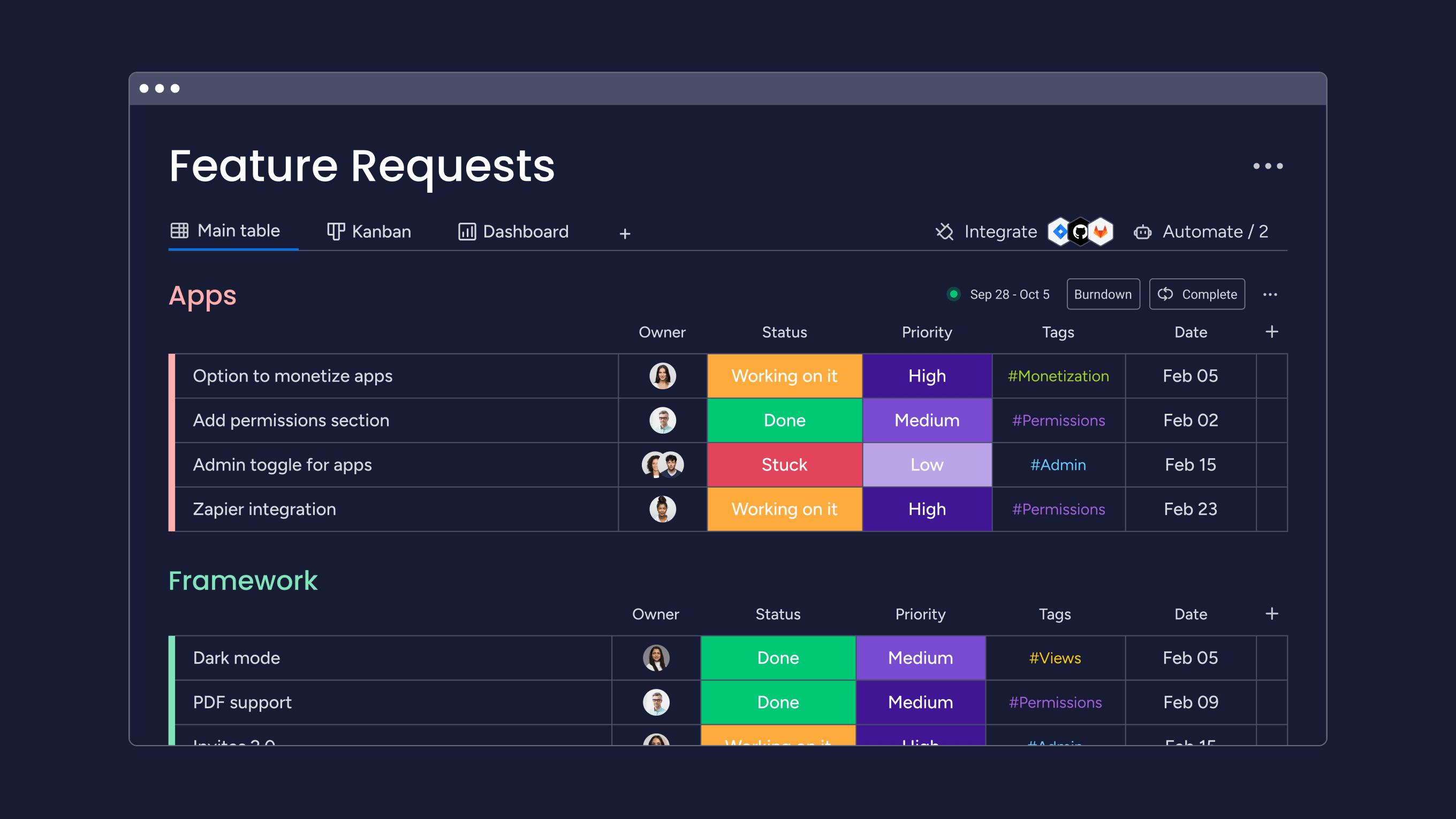
- Collaborative workspace: Share files, communicate instantly, and make real-time changes, ensuring all team members can access the latest technical specification details.
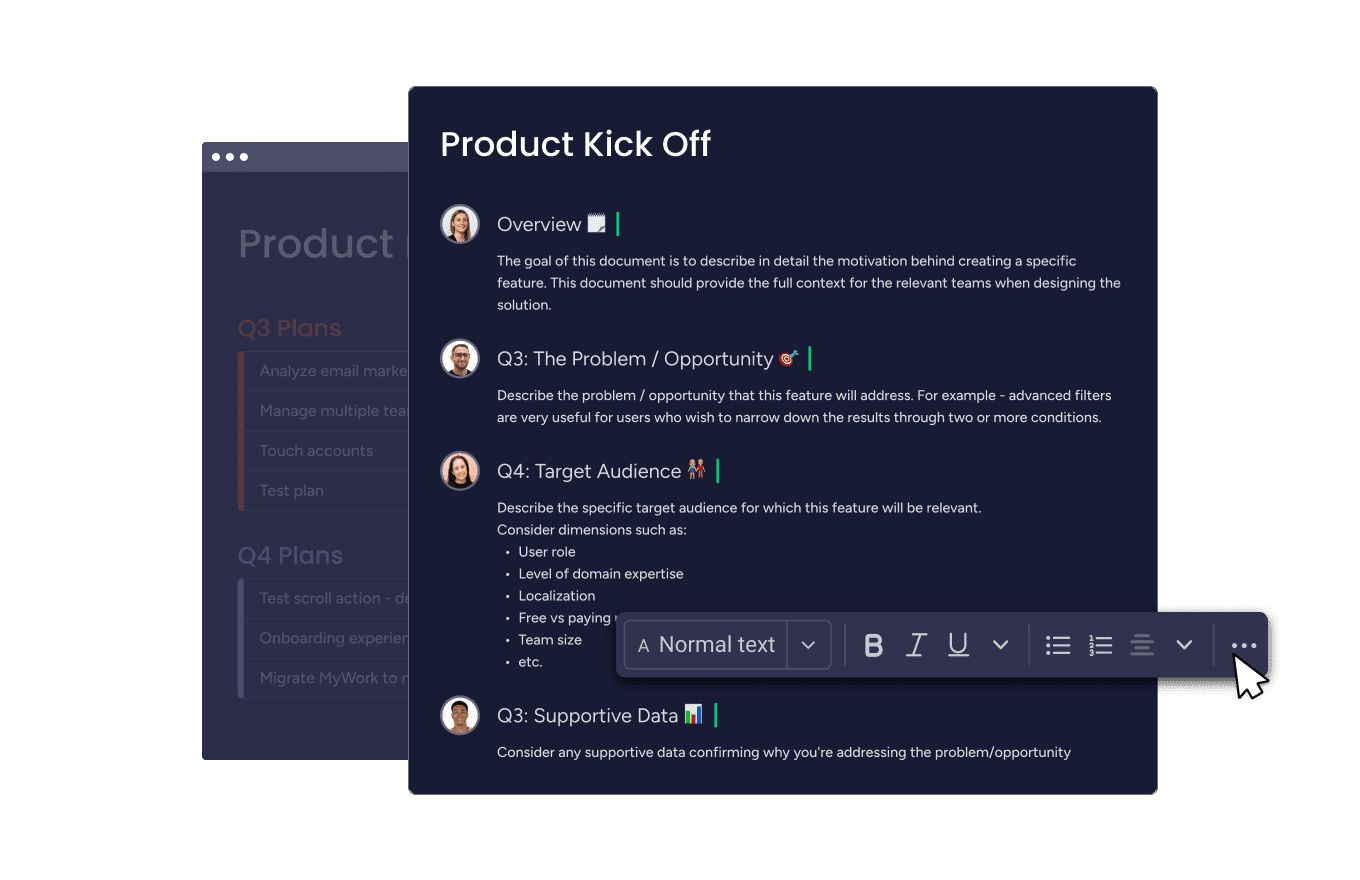
- Integration capabilities: Connect with tools like GitHub and GitLab to link code repositories and pull requests directly to your technical specification items.
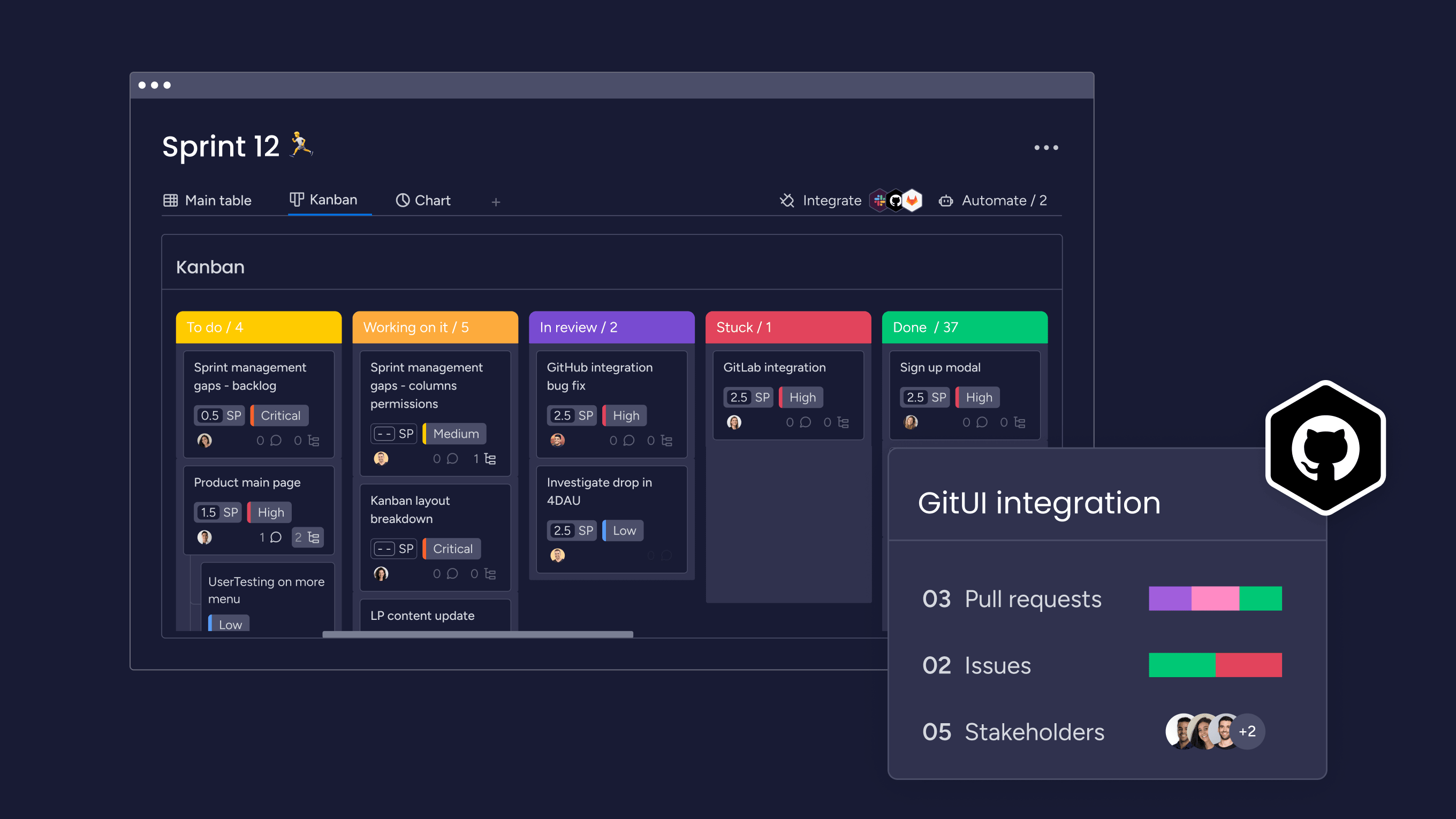
- Visual representations: Utilize various views like Kanban boards (above) and Gantt charts (below) to visualize your technical specification progress and dependencies.
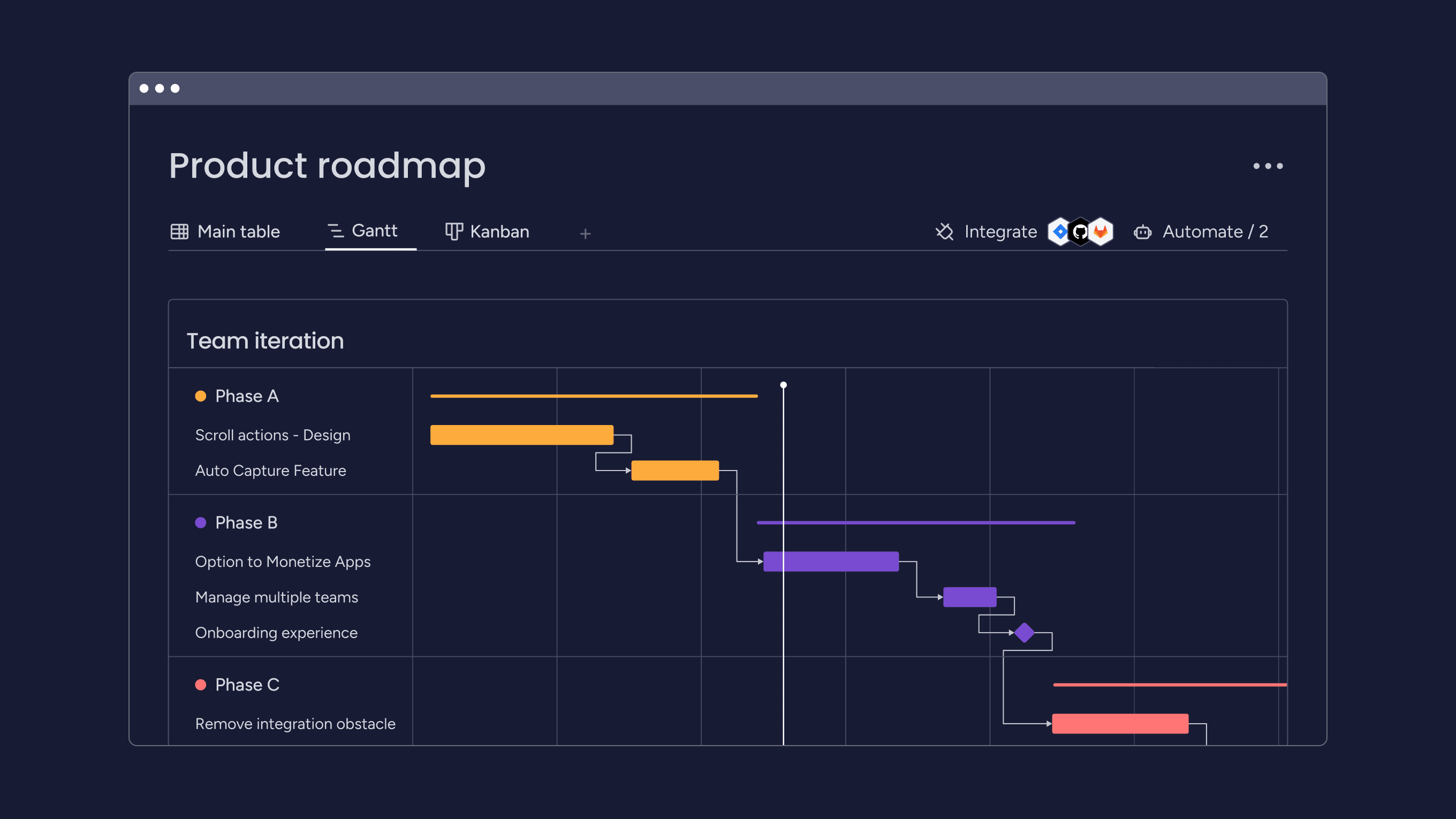
- Automation features: Set up automations for task assignments, notifications, and workflow integrations to streamline the technical specification process.
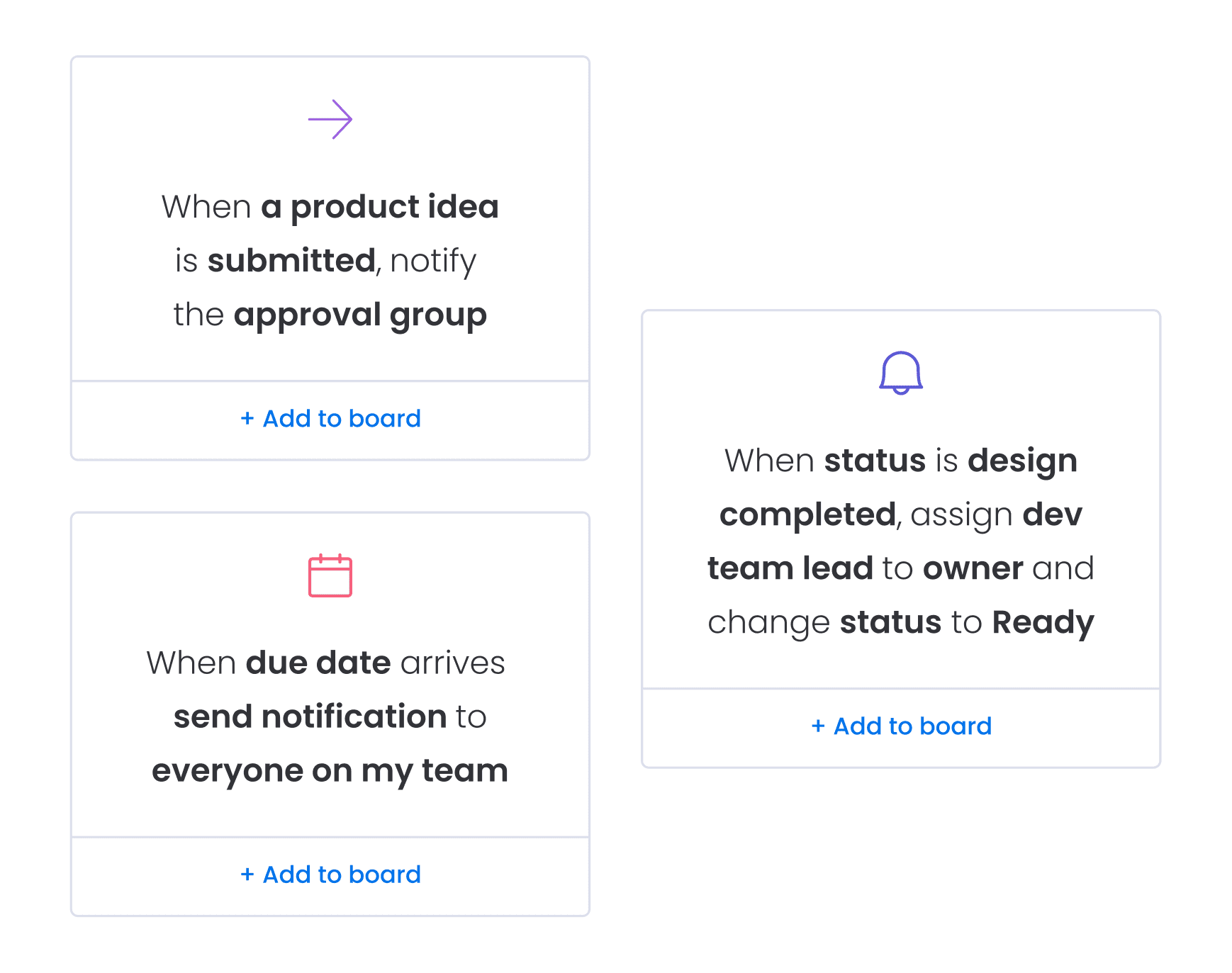
- Sprint management: Plan and track sprints, which can be helpful in the iterative development of technical specifications.
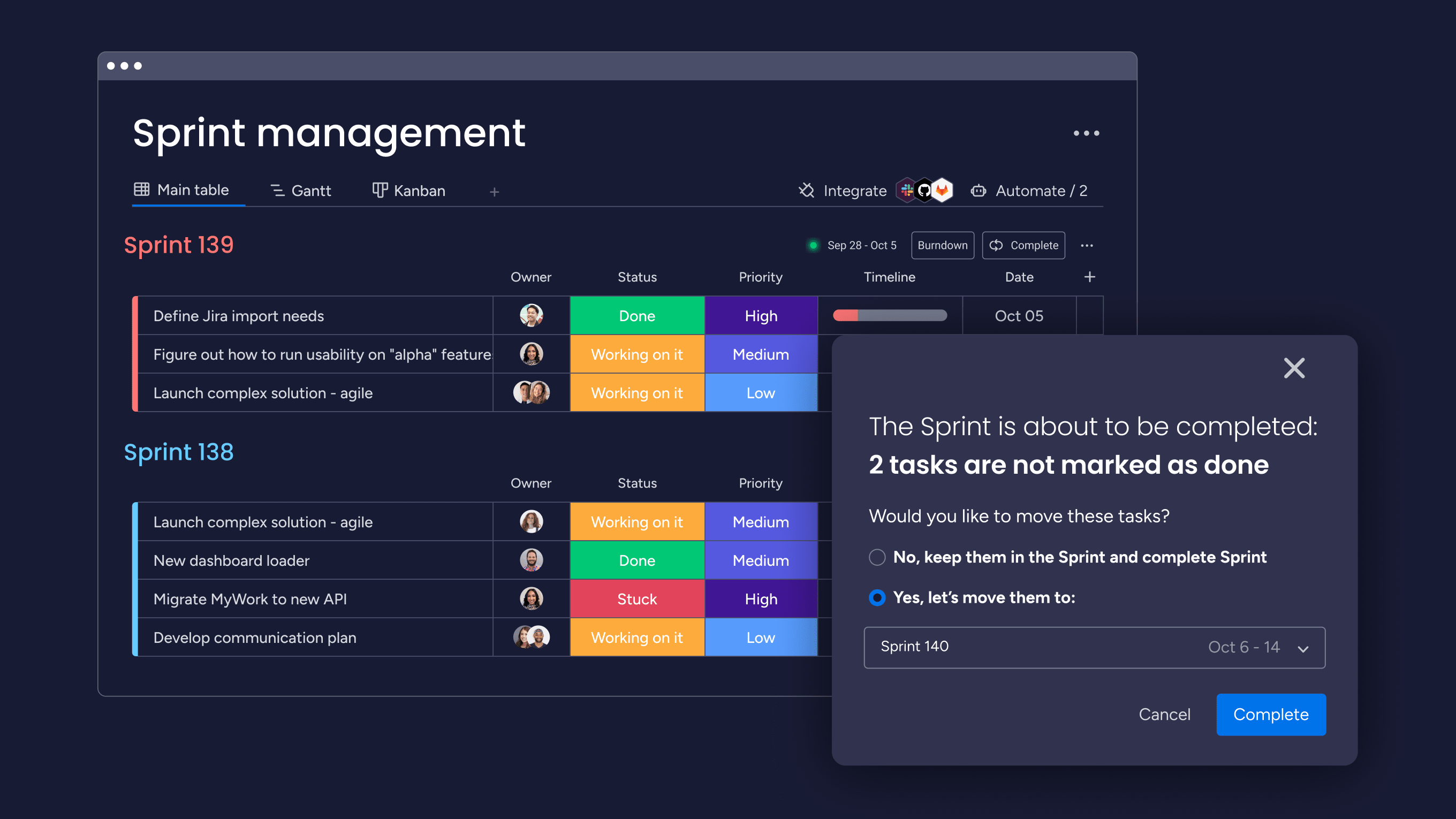
By leveraging these features, monday dev can help teams create, collaborate on, and manage technical specifications more efficiently throughout the product development lifecycle.
Try monday devRelated templates on monday dev
Here’s a selection of related templates to get your development projects up and running in next-to-no time.
Product development planning
Our product development planning template — which we call a product roadmap template — serves as a centralized repository for planning, building, and managing your sprints. It allows you to track progress, deadlines, owners, and more. Thanks to our product development planning template, organizing and tracking sprints has never been easier.
Features and releases roadmap template
Organize your product and feature release goals in one place with our features and releases roadmap. Assign priorities to major releases, get automatic deadline reminders, and view team feedback while keeping your roadmap tidy. With our roadmap template, you have a clear plan to manage and execute releases for each quarter.
Scrum software development template
The Scrum software development template keeps your team on track by allowing you to prioritize your backlog, track bugs, and reflect on previous sprints. Your projects have never been this organized.
Kanban software development template
Use the Kanban software development template to manage your Kanban workflow while improving efficiency. This is done by monitoring progress, assigning action priorities, and keeping your plan firmly in view with our premade Kanban stages.
FAQs
What is the meaning of technical specification?
As the name suggests, this document provides details and specifics about the practical elements of a project. A technical specification outlines and motivates any technical aspect of your product development plan.
What are technical specifications used for?
Technical specifications provide clarity on specific details of a software development project. They keep your team working on the same goals with a firm idea of how to go about it. They are also used to keep stakeholders in the loop.
How do you write a technical specification?
To write a technical specification, gather all relevant information about the project, including requirements and constraints, and then create a structured document outlining the technical details, design, functionality, and implementation plans. Use clear language and include sections like introduction, scope, functional requirements, technical standards, and implementation approach to provide a comprehensive blueprint for the development team.
What makes a good technical specification?
A good technical specification is clear, detailed, and well-structured, providing comprehensive information about the project's requirements, design, and implementation plans. It should be tailored to its audience, using precise language that avoids ambiguity. It should also include visual aids and examples to enhance understanding and ensure all stakeholders understand the project objectives.
What is in a technical specification?
A technical specification typically includes key components such as an introduction, purpose and scope, functional and design requirements, technical standards, solutions, testing requirements, and delivery specifications. It outlines the technical details of a project, including how the product or system will behave, what it can and cannot do, and how it will be developed, serving as a comprehensive blueprint for the development team.
What is a technical specification document?
A technical specification document (TSD) is a comprehensive blueprint outlining the technical requirements, design, and functionality of a product, system, or project. It serves as a detailed guide for development teams, bridging the gap between business requirements and technical implementation, and typically includes components such as functional and non-functional requirements, system architecture, performance criteria, and implementation plans.
What are the six main parts of a technical specification document?
The six main parts of a technical specification document typically include: (1) Front matter, e.g. title, author, date, etc. (2) Introduction and overview, (3) Purpose and scope, (4) Functional requirements, (5) Design requirements, and (6) Technical standards.
 Try monday dev
Try monday dev 
